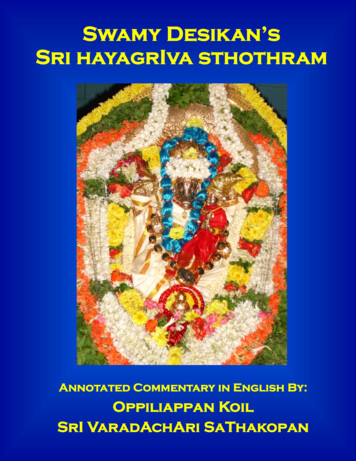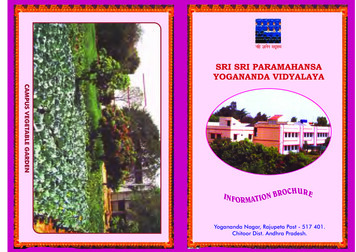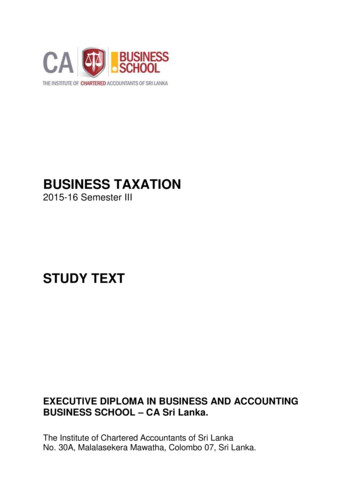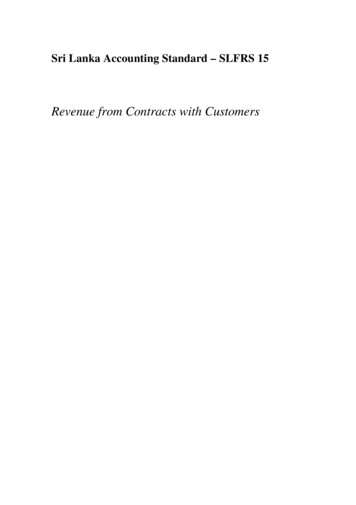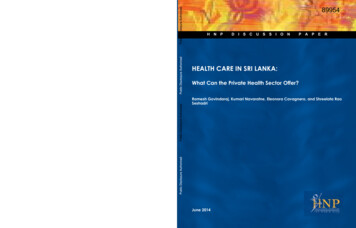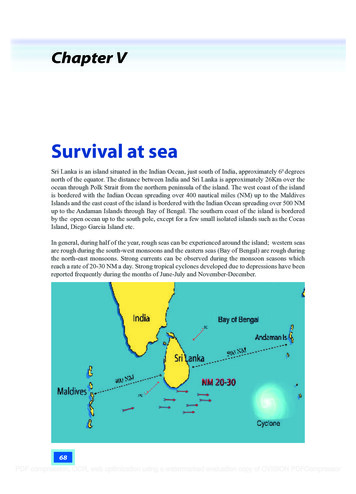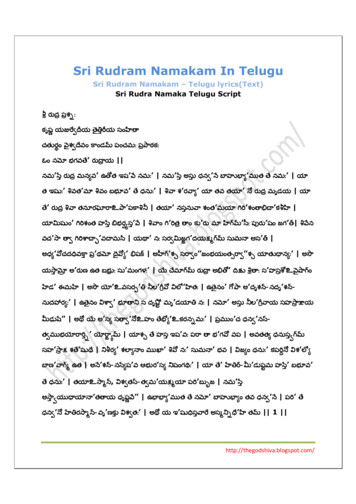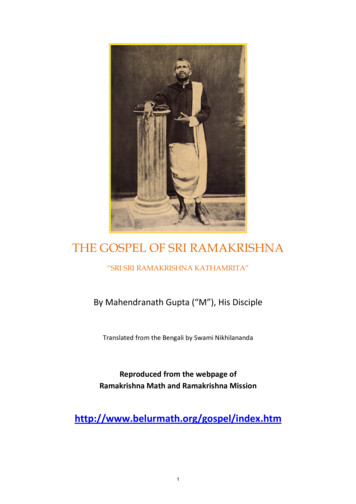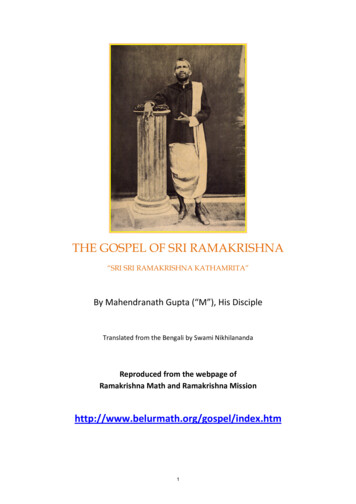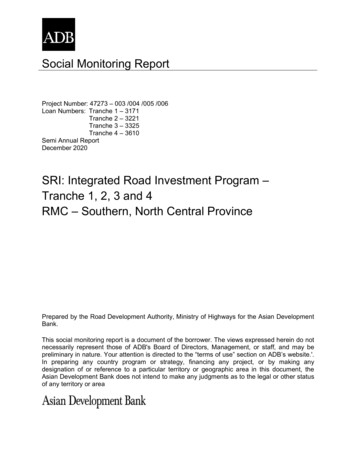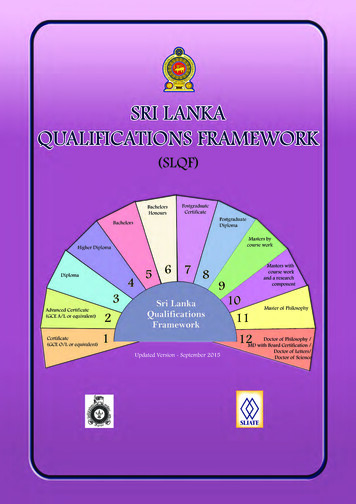
Transcription
SRI LANKAQUALIFICATIONS catePostgraduateDiplomaBachelorsMasters bycourse workHigher DiplomaDiploma43Advanced Certificate(GCE A/L or equivalent)Certificate(GCE O/L or equivalent)5 67 8921011112Updated Version - September 2015Master of Philosophy
University Grants Commission (UGC) 2015Approved by the UGC on 17 September 2015 at the 925th meeting.First edition: December 2015Published by:The World Bank fundedHigher Education for Twenty First Century (HETC) Projectof the Ministry of Higher EducationAddress: 23/135, Diyawanna Gardens,Chandra Silva Mawatha,NugegodaEmail: ppdu@hetc.lkWeb: www.hetc.lkRights and Permission:The material in this publication is copyrighted. Any part of this document may bephotocopied for academic purpose.All queries should be addressed to:University Grants Commission (UGC)Cover designed by:Ama H.Vanniarachchy, HETC ProjectISBN 978-955-4510-01-2
TABLE OF CONTENTSINTRODUCTION .Page 3AIM AND OBJECTIVES OF SLQF .Page 5KEY BENEFITS .Page 6GENERAL PRINCIPLES .Page 7Levels of Qualifications .Page 7Naming of Qualifications .Page 7Volume of Learning .Page 8SLQF Levels 7, 8 and 9 .Page 9Table 1: Minimum Volume of Learning required foreach level of SLQF .Page 10Table 2: Different SLQF Levels with Higher EducationQualification Types and Comparable Levels of NVQF .Page 11Learning Outcomes .Page 12Qualification Descriptors .Page 13Level Descriptors .Page 14Table 3:QUALIFICATION DESCRIPTORS for SLQ Levels 1 to 6 . QUALIFICATION DESCRIPTORS for SLQ Levels 7 to 12 .Page 18Page 22Table 4:Page 26LEVEL DESCRIPTORS for SLQ Levels 7 to 12 . Page 28LEVEL DESCRIPTORS for SLQ Levels 1 to 6 PROGRESSION PATHWAYS .Page 32ABBREVIATIONS AND ACRONYMS .Page 361
2
INTRODUCTIONThere has been a significant increase in the mobility of learners and academics in therecent past across countries and regions of the world requiring national highereducation systems to support and accommodate such developments. In that light,the Sri Lanka Qualifications Framework (SLQF) is an important element of systemsdevelopment in the higher education sector, which at the end offers a transparentand coherent framework for the learner to optimize his/her objective of learningthroughout life, while at the same time improving many vital aspects of learning andassessing the learning process. The establishment of the SLQF will help improvemany aspects and processes in the learning and the methods of delivery. It will alsoenhance the quality of education at home while at the same time provide a clearsystem to develop links with the higher education institutions abroad.The SLQF is a nationally consistent framework for all higher education qualificationsoffered in Sri Lanka. The SLQF applies to all higher education institutions (HEIs)both public and private, which provide post-secondary education. It recognizes thevolume of learning of students and identifies the learning outcomes that are to beachieved by the qualification holders. The SLQF comprises twelve levels and thedescriptors of each of these levels are comprehensively defined. Since the volume oflearning is considered in the SLQF, the number of credits that should be earned bystudents for each qualification is also given. With the objective of having a uniformsystem in naming a qualification, the designators and qualifiers of each qualificationhave been identified in the SLQF. The abbreviations for each qualification were alsoidentified to maintain uniformity. The purposes and scope, and attributes expectedfor the award of each qualification, as well as the minimum admission requirementsalong with possible progression opportunities are also stated in the SLQF.The SLQF integrates the National Vocational Qualifications Framework (NVQF)developed by the Tertiary and Vocational Education Commission and the pathwaysof lateral mobility between the vocational education sector and the higher educationsector have also been identified. The SLQF helps in the recognition of accreditedprior learning in order to facilitate the vertical mobility within the higher educationsystem.With the globalization of higher education, national qualifications frameworks havebeen developed in many countries. These have not only helped to evaluate thehigher educational qualifications obtained from different countries but also havefacilitated the appropriate international interpretation of national qualificationlevels. The SLQF also contributes to the evaluation of qualifications obtained fromcross border HEIs as the levels identified in this framework are based on the learningoutcomes of the qualification holders. The SLQF will assist in the evaluation and3
recognition of qualifications offered by Sri Lankan HEIs and this will be useful to thequalification holders to identify the level of their qualifications. In addition, theSLQF will assist potential employers to know the level of learning and the attributesof a particular qualification holder.The SLQF is useful to the HEIs, both in the state sector and non-state sector indesigning courses as the minimum level of learning outcomes required for eachqualification is indicated by the minimum number of credits that should be earnedby a qualification holder. Thus, the SLQF will contribute towards strengthening thequality of higher education qualifications offered by universities and other HEIs inSri Lanka.The SLQF does not deal with the designing and offering of short term courses by anyHEI that will meet specific learning outcomes. These courses may be of a few monthsduration and a certificate may be awarded on completion of such courses. Thosecertificates are not aligned with the qualifications identified in the SLQF. In addition,honorary degrees and certificates of attendance are not included in the SLQF. Thehonorary doctorate is differentiated from doctoral degrees in the SLQF.This is an updated version of the SLQF published by the Ministry of HigherEducation (First Edition in June 2012, Second Edition in October 2012 and ThirdEdition in January 2013) and this version supersedes all previous versions.4
AIM AND OBJECTIVES OF SLQFThe aim of the SLQF is to create an integral national framework for learningachievements by recognizing and accrediting qualifications offered by differentinstitutions engaged in higher education and vocational training in Sri Lanka.The objectives of the SLQF are to;i) enhance the quality of higher education and training at all levels;ii) facilitate access to higher learning and thereby contribute to fullpersonal development of learners and to social and economicdevelopment of the country;iii) enhance equity in higher education, training and employmentopportunities;iv) assist employers to identify the levels of knowledge, skills andcompetencies of qualification holders;v) develop positive attitudes in qualification holders;vi) facilitate lateral and vertical mobility, and progression withinhigher education and career pathways;vii)provide guidance in comparing qualifications offered by differentinstitutions;viii) help in developing higher education and vocational trainingprogrammes at appropriate levels;ix) recognize prior learning; andx) promote lifelong learning.5
KEY BENEFITSThe SLQF will be useful to all stakeholders of higher education including students,parents, employers, as well as education and training providers. 6For learners, the SLQF will be useful to recognize and evaluate priorlearning and identify the pathways of acquiring higher qualifications. Thiswill enable learners to develop their full potential and thereby contributeto the social and economic development of the country at large.The level descriptors given in the SLQF will be useful for employers toidentify the levels of competencies of qualification holders. It will also helpin comparing the qualifications so that the supply and demand forknowledge, skills and competencies could be properly matched. Further,the SLQF will be useful in comparing the qualifications offered bydifferent institutions. This will help the employers to find appropriatequalification holders for their business needs.The SLQF describes the credit requirements for each qualification level aswell as intended learning outcomes. Therefore, for higher educationproviders, both in the state and private sectors, the SLQF will be useful indesigning their academic programmes.The SLQF enables all stakeholders of post-secondary education to identifythe full range of qualifications offered in the higher education system inSri Lanka and comparable levels of vocational education and training. Thishelps to understand how qualifications are related to each other and howthey contribute to the enhancement of knowledge and understanding, andimprovement of intellectual abilities including analytical skills, evaluationskills, problem solving skills and soft skills.The SLQF will also be useful to the general public to have access toappropriate lifelong education and training, which helps them to fulfilltheir personal as well as social and economic potential.The SLQF will be useful to programme approving agencies to identify theappropriate levels of qualifications offered by different HEIs. Further, ithelps in evaluating different qualifications offered by HEIs, both local andforeign, which will be useful when taking decisions in recruitment andpromotion in the academic, technical and professional sectors.
GENERAL PRINCIPLESLevels of Qualifications The SLQF consists of twelve levels. The demand for learning outcomesand complexity of learning increase with each level. The first two levels(levels 1-2) are senior secondary level education qualifications and the nextfour levels (levels 3-6) are undergraduate qualifications. The other sixlevels (levels 7-12) are postgraduate qualifications. The levels are notnecessarily directly related to the years of study.The SLQF levels, the qualifications awarded at each level and theminimum credit requirement for each level are summarized in Table 1.The comparable levels of NVQF are also identified in the SLQF. Differentlevels of the SLQF with some examples and comparable NVQF levels aregiven in Table 2.Naming of Qualifications Qualification type is the first name given to a qualification. The SLQFcomprises the following qualification types:Senior Secondary Level: - Certificate, and Advanced CertificateUndergraduate Level: - Diploma, Higher Diploma, Bachelors, andBachelors HonoursPostgraduate Level: -Postgraduate Certificate, Postgraduate diploma,Masters, and DoctorateIn principle, irrespective of the length of the programme, all BachelorsDegrees and Bachelors Honours Degrees are placed respectively at level 5and level 6 in the SLQF.The designator is the second name given to a qualification. This indicatesthe broad area of study or discipline. All degrees, i.e., Bachelors, Mastersand Doctoral degrees have designators. The examples are Bachelor of Arts,Bachelor of Science, Master of Commerce, Doctor of Philosophy andDoctor of Science. However, designators are not used for Diplomas andCertificates. The linking word between the qualification type anddesignator is ‘of’, which is omitted when abbreviating. E.g. BA, BSc,MCom.The qualifier is the third name given to a qualification. This is used toindicate the field of specialization of a qualification. The qualifier may beused in most qualification types. The linking word between the qualifierand the qualification type or its designator, as the case may be, is ‘in‘.Some examples are Bachelor of Science Honours in Chemistry,Postgraduate Certificate in Library Science, and Master of Philosophy in7
Environmental Science. When abbreviating, the word ‘in’ is dropped andthe qualifier is placed within brackets. E.g. PGCert (Lib Sc), MPhil (EnvSc), BScHons (Chemistry).Some qualifications may include a second qualifier too. This secondqualifier qualifies the first qualifier. Examples are Bachelor of Science inEngineering in Mechanical Engineering. When abbreviating bothqualifiers are placed within brackets and the words ‘in’ are dropped. E.g.BSc (Eng) (Mech Eng).When there is no designator, the qualifier may follow the qualificationtype. E.g. Postgraduate Diploma in Environmental Management. Whenabbreviating, the word ‘in’ is dropped and the qualifier is placed withinbrackets. E.g. PGDip (Env Mgmt). The qualification types that do not havea designator may include a second qualifier too; E.g. PostgraduateCertificate in Fine Arts in Drama. Such a qualification is abbreviated asPGCert (Fine Arts) (Drama).In order to use a qualifier, at least 50% of the minimum total credits for thequalification and at least 50% of the minimum number of credits at the exitlevel of the qualification must be in the field of specialization denoted bythe qualifier. The same applies to the second qualifier as well.Volume of Learning The volume of learning at each level is described in terms of credits. In the SLQF credit system, the student workload of a study programme isdefined as 1500 notional learning hours per academic year. The notional learning hours include direct contact hours with teachers andtrainers, time spent in self-learning, preparation for assignments, carryingout assignments and assessments. The need to undertake any or all ofthese will be considered when a credit is being allocated to a course unit ora module, when the syllabus is designed. It is understood that thecombination of learning activities may vary from one course unit ormodule to another. In designing a particular course unit or a module, its workload should becomputed based on the total amount of learning activities a student isexpected to complete in order to achieve the foreseen learning outcomesand the workload expressed in time should match the number of creditsavailable for the course unit or module. The minimum number of credits per course unit or module is 1. Thenumber of credits per course unit or module should be indicated by wholenumbers. One credit is considered equivalent to 50 notional learning hours for ataught course, laboratory studies course or field studies/clinical work. Incase of industrial training, including time allocated for assessments and in8
case of research, including time allocated for literature survey, one creditis considered equivalent to a minimum of 100 notional hours.Learning outcomes must be assessed by valid and reliable methods ofassessment. Credits have to be earned by students after successfulcompletion of the work required and appropriate assessment of learningoutcomes.Every qualification type of Levels 1 - 12 on the SLQF has a credit valueallocated to each of its component parts and to the whole qualification.SLQF Levels 7, 8 and 9 Under the qualification types Postgraduate Certificate, PostgraduateDiploma and Masters by course work, there are two broadly variedcategories of study programmes practiced in the country. Postgraduate Certificate, Postgraduate Diploma and Masters by coursework that are designed to extend students’ depth of knowledge in aparticular field, building on an area in which they already have expertise,gained at undergraduate level are defined as extension programmes. Postgraduate Certificate, Postgraduate Diploma and Masters by coursework that are intended to those with little or no prior knowledge of thesubject, offering an education similar in knowledge to that of anundergraduate study programme but broadening students’ academicabilities and bringing graduates of other subjects to graduate competencein the named subject are defined as conversion programmes. For example, if the Postgraduate Diploma in Sociology is a studyprogramme that is designed to admit candidates having a Bachelor ofScience Honours degree in Chemistry, then such a Postgraduate Diplomais of conversion category. On the other hand, if the Postgraduate Diplomain Sociology is a study programme that is designed to admit only thecandidates who have studied Sociology in a Bachelor or Bachelor Honoursdegree, then that Postgraduate Diploma is of extension category. SLQF Levels 7, 8 and 9 are kept only for the respective PostgraduateCertificate, Postgraduate Diploma and Masters by course work ofextension category. Postgraduate Certificate, Postgraduate Diploma andMasters by course work of conversion category are placed in the SLQF atLevel 6.9
Minimum volume of learning required for each Level of SLQFSLQFLevelQualification AwardedMinimum Volume of Learningfor the Award9Doctor of Philosophy / MDMinimum 3 years of fulltime orwith Board Certification/Doctor equivalent time of originalof Letters/Doctor of Scienceresearch after SLQL 6 or aboveMinimum 2 years of fulltime orMaster of Philosophyequivalent time of originalresearch after SLQL 6 or above60 credits after SLQL 5 or SLQL 6Masters with course work andincluding a research componenta research componentof minimum 15 credits30 credits after SLQL 5 or SLQL 6Masters by course work*8Postgraduate Diploma*25 credits after SLQL 5 or SLQL 67Postgraduate Certificate*20 credits after SLQL 5 or SLQL 61211106Bachelors Honours5Bachelors4Higher Diploma3DiplomaAdvanced Certificate (GCE A/Lor equivalent)Certificate (GCE O/L orequivalent)Table 121120 credits after SLQL 2of which 90 credits after SLQL 3,of which60 credits after SLQL 4,of which 30 credits after SLQL 590 credits after SLQL 2of which 60 credits after SLQL 3,of which 30 credits after SLQL 460 credits after SLQL 2of which 30 credits after SLQL 330 credits after SLQL 2*Only the extension category study programmes that lead to PostgraduateCertificate, Postgraduate Diploma and Masters by course work are placed at SLQFLevels 7, 8 and 9 respectively. Conversion category study programmes that awardPostgraduate Certificate, Postgraduate Diploma or Masters by course work areplaced at SLQF Level 6.10
Different SLQF Levels with Higher Education Qualification Typesand Comparable Levels of NVQFThe comparable NVQ and SLQF levels have been recognised on the basis ofsignificant similarities in the learning outcomes stated under respective leveldescriptors in the two frameworks by a panel of experts. Degree level qualification(NVQ 7) is benchmarked to internationally accepted standard for a Bachelor degree(SLQF Level 5). Nonetheless, the proportion of cognitive outcomes and psychomotoroutcomes may differ in the two qualifications, especially in qualifications belowSLQF 2 (NVQ 4). Further, the attributes of two qualification holders, below thedegree level, at comparable SLQF and NVQ levels may differ.SLQFLevelQualification awardedComparable NVQLevels12Doctor of Philosophy / MDwith BoardCertification/Doctor ofLetters/Doctor of Science11Master of Philosophy10Masters with course workand a research component9Masters by course work8Postgraduate Diploma7Postgraduate Certificate6Bachelors Honours5Bachelors743Higher DiplomaDiploma652Advanced Certificate (GCEA/L or equivalent)41Certificate (GCE O/L orequivalent)32Table 211
Learning Outcomes 12Learning outcomes are statements that describe what learners shouldknow, understand and can demonstrate upon the completion of a courseor study programme.In SLQF, the learning outcomes are stated in two parts.The first part, called the attributes of the qualification holders, is a set ofgeneral statements of the wider abilities that the typical student is expectedto have developed by the end of the course or study programme. It will beuseful for HEIs to share with stakeholders the general capabilities of theholders of the qualification. It is by first considering these attributes thatthe learning outcomes in the level descriptors are defined. Hence, in thissense, these attributes could be termed as precursors to the studyprogramme learning outcomes, rather than the actual learning outcomes.The second part, called the level descriptor, is a set of specific outcomestatements, achievement of which is assessed and which a student shouldbe able to demonstrate for the fulfilment of requirements of thequalification i.e. the specific broad abilities that the graduate should becapable of, for award of the qualification. This part will be of significanceto the HEIs to systematically design and review courses or studyprogrammes. It is essential that the curriculum and assessments to provideall students with the opportunity to achieve, and to demonstrate theachievement of the intended outcomes stated under respective leveldescriptors.Comprehensive statements on the expected specific learning outcomes inparticular subject areas are not addressed in the SLQF. They are availablein the respective subject benchmark statements for the Bachelors andBachelor Honours qualifications.Some qualification types may consist of one or more levels of partqualifications. For example, the SLQ levels 3, 4 and 5are normallycorresponding sequentially to the first, second and third years of anundergraduate study programme leading to Bachelors qualification type.However, there is no expectation that, for example, the learners shouldnecessarily follow all Level 3 course units or modules only during the firstyear of undergraduate study. The HEI has the freedom to determine themost appropriate structure and progression towards achieving theintended attributes for the award of the qualification.
Qualification descriptors The qualification descriptors stated in the SLQF for each level provide thespecifications such aso the SLQF exit level,o the qualification type with designators and the qualifiers,o the number of credits required at each level,o the purpose and scope, and the generic outcomes and attributesexpected for the award of each qualification,o the minimum admission requirements ando the possible progression opportunities (Table 3).For each qualification, the generic outcomes and attributes signify theexpected capabilities from qualification holders defined in terms of thefour main domains of learning: knowledge; skills; attitudes; and mind-setand paradigm, characterised as the K-SAM model.Knowledge: what the qualification holders knowSkills: what the qualification holders can doAttitudes, Values, Professionalism and Vision for life: how thequalification holders think and behaveMind-set and Paradigm: how the qualification holders perceive the world The K-SAM model is considered an integrated model. Thus, each learningoutcome identified under the attributes of a particular level may not beconfined to a single domain within the K-SAM model. For example,communication skills (i.e. a learning outcome) is not considered only as askill (i.e. a single domain of the K-SAM model). The SLQF recognizes agiven learning outcome as a blend of more than one domain (in most casesall the domains) in the K-SAM model.13
Level Descriptors The level descriptors identify the learning outcomes at each level. Indescribing each level, the degree of intellectual abilities, cognitive skillsand soft skills are considered.The purpose of the level descriptors for the SLQF levels 1 to 12 is toguarantee consistency across learning in achieving the expected attributesof qualifications through part-qualification levels, and to help a HEI toevaluate the comparability of qualifications and part-qualifications issuedby another HEI (Table 4). The level descriptors may also be used as aguideline to develop course materials of a particular study programmehaving several course units or modules in order to make sure that thelearners’ could progressively meet the expected attributes of the relevantqualification type at the end of the course.The following twelve learning outcomes identified by the Ministry ofHigher Education in Sri Lanka as of national importance have beencustomized as level descriptors to suit each level of qualification. Thecategorization of the learning outcomes according to the principal K-SAMcomponents is as follows:Categories of Learning Outcomes1. Subject / Theoretical Knowledge2. Practical Knowledge and ApplicationCore AreaKnowledge3. Communication4. Teamwork and Leadership5. Creativity and Problem Solving6. Managerial and EntrepreneurshipSkills7. Information Usage and Management8. Networking and Social Skills9. Adaptability and Flexibility10. Attitudes, Values and ProfessionalismAttitudes, Values, Professionalism andVision for life11. Vision for Life12. Updating Self / Lifelong Learning 14Mind-set and ParadigmSome of the commonly used student-centred teaching and learning methodsrecommended for the respective learning outcomes are given below:
Categories of Learning outcomes1. Subject / Theoretical KnowledgeStudent-centred teaching and learningmethodsIndependent learning activities, interactivelectures, team-based learning, and othersmall group activitiesProblem-based learning, team-based2. Practical Knowledge and Application learning, inquiry-based learning, practicalclasses, laboratory sessions, role play3. CommunicationStudent presentations, role play, debates,dramas4. Teamwork and LeadershipGroup projects, industrial training, smallgroup learning; e.g. problem-based learning,games5. Creativity and Problem SolvingAssignments, projects, small group learningactivities; e.g. problem-based learning6. Managerial and EntrepreneurshipGroup projects, industrial training, smallgroup learning; e.g. problem-based learning,games, simulated training, industrial(workplace-based) training7. Information Usage and ManagementAssignments, presentations, projects, casestudies8. Networking and Social SkillsStudent presentations, role-play, debates,dramas9. Adaptability and FlexibilityGroup projects, industrial training, smallgroup learning; e.g. problem-based learning,role plays, portfolios10. Attitudes, Values andProfessionalismGroup projects, industrial training, smallgroup learning; e.g. problem-based learning,role play, portfolios11. Vision for LifePortfolios, reflective practice12. Updating Self / Lifelong LearningPortfolios, reflective practice The learner is expected to meet or demonstrate that certain learning outcomeshave been achieved. Therefore, the assessment of the outcomes of learning byeffective and appropriate assessment methods is essential in the process of thequalification framework.15
16
Sri Lanka Qualifications FrameworkQualification Descriptors andLevel Descriptors17
Table 3QUALIFICATION DESCRIPTORS – SLQF Levels 1 to 6SLQF Exit levelQualification TypePurpose and ScopeofQualificationSLQFLevel 1CERTIFICATESLQFLevel 2ADVANCEDCERTIFICATEComparable to GCE(Ordinary Level)qualificationComparable to GCE(Advanced Level)qualificationSLQFLevel 3DIPLOMAThe purpose of thisqualification is to producea person with focusedknowledge and skills in aparticular field for therequirement of the labourmarket.This qualification isbasically occupational orvocational specific. Itcombines in-depthknowledge in a particularfield with practicalexperience aimed atacquiring required skills ina work place. Theseprogrammes usuallyinclude simulated workexperience or workintegrated learning.SLQFLevel 4HIGHER DIPLOMASLQFLevel 5BACHELORSDEGREESLQFLevel 6BACHELORS HONOURSDEGREEThe purpose of thisqualification is to offer anintensive, focusededucation in a particulararea of specialization tomeet the requirements ofthe labour market.The purpose of thisqualification is to prepare agraduate with a broadknowledge on theory,practice and methodologyof disciplines that enablethem to bear responsibilityin an academic orprofessional environment.Purpose of this qualification is toprovide a broad education in aparticular discipline in order to equipgraduates with knowledge, practiceand methodology that enable them toobtain appropriate professionalstatus/qualification or prepare them forresearch/practice based postgraduatestudies.This qualification helps to consolidateand strengthen the student’sknowledge in a particular disciplineand to develop research capacity andskills in that discipline. Thisqualification demands a high level oftheoretical engagement and intellectualindependence. Further, theseprogrammes must include a researchcomponent in the field of specializationcarried out under the guidance andsupervision of a qualification holder oflevel 10, 11 or 12 and reporting in amanner of a report/dissertation, whichwill be assessed. The researchcomponent should not be less than atotal of at least 6 credits of SLQ level 6.In some areas, Bachelors Honoursdegrees are recognized by anappropriate professional body.18
Comparable to theholders of GCE(Ordinary Level)qualificationKSAttributes ofQualificationHoldersAComparable to theholders of GCE(Advanced Level)qualificationThe qualification holders:-Should have anunderstanding of theory,practice, relevantmethodology and recentdevelopments in a particulararea of study.The qualification holders:-Should have a deepunderstanding of theory,practice, relevantmethodology and recentdevelopments in a particulararea of study.-Should be able to apply theconcepts and principles inthe area of study and suggestsolutions to problems in anemployment context.-Should be able to apply theconcepts and principles inthe area of study, analyzeinformation and suggestsolutions to problems in anemployment context.-Should be able tocommunicate successfully,the results to specialist andnon-specialist audiences andexercise personalresponsibilities andleadership in some tasks inthe workplace.-Should be capable ofcarrying out further trainingand acquire newcompetencies which willhelp to enhance theircapacity to bearresponsibilities.-Should display qualities andtransferable skills as well assubject specific skillsnecessary for employment,carry out further training andmanage their own learning.M-Should be able to
learning is considered in the SLQF, the number of credits that should be earned by students for each qualification is also given. With the objective of having a uniform system in naming a qualification, the designators and qualifiers of each qualification have been identified in the SLQF. The abbreviations for each qualification were also
